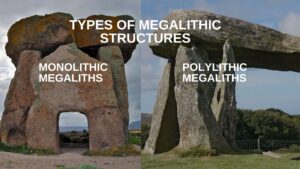Megaliths, the awe-inspiring large stone structures built during the Stone and Bronze Ages, stand as silent witnesses to the ingenuity of our ancestors. These structures, arranged in various formations like circles or standing stones, are found across the world in regions including Europe, Asia, and Africa.
Their construction, purpose, and significance provide us with a deeper understanding of prehistoric societies, their beliefs, and their technological prowess.
Purpose and Significance of Megaliths
Megaliths were primarily used for ceremonial, religious, and burial purposes. These structures served as markers for significant locations, as well as monuments for honoring the deceased. By examining megalithic sites, archaeologists can gain insights into how ancient people lived, the rituals they practiced, and how they collaborated to build these massive structures without modern tools.
Megaliths in Ancient India
In India, the history of the Iron Age is closely linked with megalithic burials and the Sangam literature. These sites are valuable resources for reconstructing historical narratives, as they reveal the lifestyle, culture, and social organization of ancient communities. The presence of numerous megalithic sites across the subcontinent has led scholars to refer to it as a “Megalithic Civilization.”

Megalithic structures in India began appearing in the Neolithic period and continued into the Chalcolithic, Bronze, and Iron Ages. They were widespread in regions such as Kashmir, the Deccan plateau, and South and Northeast India, with a particularly strong presence in the post-Neolithic sites of South India.
Archaeological Evidence from Megalithic Sites
Excavations of megalithic sites have uncovered various artifacts that provide crucial information about past societies. These findings include:
- Human remains along with burial pottery (Black and Red ware)
- Iron tools and weapons, indicating early metallurgical advancements
- Ornaments made from stone and gold
- Horse skeletons and equipment, signifying the use of domesticated animals in transportation and warfare
Some notable megalithic sites include:
- Brahmagiri: Archaeologists discovered a skeleton buried with 33 gold beads, two stone beads, four copper bangles, and a conch shell, indicating social hierarchy.
- Inamgaon (1600–700 BCE): Located near the Gond River in Maharashtra, this site features burials within houses, where the dead were laid with their heads pointing north and accompanied by food and water vessels.
Types of Megalithic Structures
Megalithic sites can be categorized into Monolithic and Polylithic types.
1. Monolithic Megaliths
These consist of a single stone and are further classified into:
- Menhirs: Tall, vertically standing stones, either isolated or in groups, varying in shape and size.
- Stone Circles: Large stones arranged in a circular pattern, possibly for ritualistic purposes.
2. Polylithic Megaliths
These structures consist of multiple stones and include:
- Dolmens: Single-chamber tombs made of three or more upright stones supporting a flat capstone.
- Cairns: Conical piles of human-arranged stones, typically found in highlands and near waterways.
- Cromlechs: Circular arrangements of vertically placed stones, often surrounding a tomb.
- Cists: Encasements for dead bodies, sometimes containing jewelry and ornaments that indicate the wealth of the deceased.
Features of Megalithic Societies
Megalithic sites offer critical insights into the social and religious structures of ancient communities:
- Ancestor Worship: Some Indian tribes, such as the Kurumbas, continue to honor their ancestors through megalithic monuments, seeking their guidance and blessings.
- Patriarchal Society: The fact that megalithic structures were predominantly dedicated to male members suggests a male-dominated social hierarchy.
- Early Use of Iron: South Indian megalithic sites mark one of the earliest uses of iron in the world. The Mayiladumparai site in Tamil Nadu, dating back to the 18th century BCE, provides the earliest evidence of iron usage in India, confirmed to be widespread by the 10th century BCE.
Megaliths serve as powerful symbols of ancient human innovation and spiritual beliefs. Their study sheds light on the social structures, religious practices, and technological advancements of prehistoric civilizations.
These monumental stones not only mark burial sites and ceremonial locations but also highlight the transition from nomadic to settled communities. As we continue to explore these relics of the past, they provide invaluable insights into the evolution of human civilization.
For further exploration of Ancient Indian History, consider reading about:


